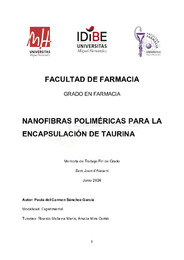Please use this identifier to cite or link to this item:
https://hdl.handle.net/11000/33091Full metadata record
| DC Field | Value | Language |
|---|---|---|
| dc.contributor.advisor | Mallavia, Ricardo | - |
| dc.contributor.advisor | MIRA CARRIÓ, AMALIA | - |
| dc.contributor.author | Sánchez García, Paula del Carmen | - |
| dc.contributor.other | Departamentos de la UMH::Farmacología, Pediatría y Química Orgánica | es_ES |
| dc.contributor.other | Instituto de Investigación, Desarrollo e Innovación en Biotecnología Sanitaria de Elche | es_ES |
| dc.date.accessioned | 2024-09-13T09:39:37Z | - |
| dc.date.available | 2024-09-13T09:39:37Z | - |
| dc.date.created | 2024-05-22 | - |
| dc.identifier.uri | https://hdl.handle.net/11000/33091 | - |
| dc.description.abstract | Cada vez es más común el uso de la técnica de electrohilado para la creación de nanofibras donde se pueden encapsular metabolitos para investigar sus propiedades y funciones. Al fabricar nanofibras aumenta la superficie de absorción que presenta el fármaco y, por tanto, su absorción. Con este trabajo de fin de grado se busca encapsular taurina mediante nanofibras usando PMVEMA-Ac [poli (metil vinil éter-altácido maleico)] y PMVEMA-Es [poli (metil vinil éter-alt-ácido maleico monoetil éster)]. Para poder electrohilar una sustancia ha de ser lo suficientemente viscosa, entre 100 y 2000 cP, es por ello por lo que primero se midió la viscosidad de las disoluciones poliméricas para comprobar que efectivamente se podían electrohilar. Mediante la microscopía óptica y electrónica (FESEM) se realizó una caracterización cualitativa de la morfología de las nanofibras, resultando en fibras homogéneas con PMVEMA-Ac y fibras heterogéneas con el PMVEMA-Es. Los diámetros de estas fueron 318 ± 17 nm para las de PMVEMA-Ac y de 456 ± 180 nm para PMVEMA-Es. De forma cualitativa se utilizó la espectroscopía infrarroja donde se observó que se había conseguido encapsular taurina dentro de las nanofibras, así que posteriormente se cuantificaron estos resultados con la técnica de cromatografía líquida de alta resolución (HPLC). Por último, se realizó un ensayo in vitro para observar la degradación de las nanofibras y la liberación de taurina a diferentes pH y diferentes tiempos. Posteriormente se cuantificó mediante HPLC para ver la cantidad de metabolito que se liberaba en función del tiempo. | es_ES |
| dc.description.abstract | The use of the electrospinning technique for the creation of nanofibers where metabolites can be encapsulated to investigate their properties and functions is increasingly common. By manufacturing nanofibers, the absorption surface of the drug increases and, therefore, its absorption. This final degree project seeks to encapsulate taurine through nanofibers using PMVEMA-Ac [poly (methyl vinyl ether-alt-maleic acid)] and PMVEMA-Es [poly (methyl vinyl ether-alt-maleic acid monoethyl ester)]. To be able to electrospin a substance it must be sufficiently viscous, between 100 and 2000 cP, which is why the viscosity of the polymer solutions was first measured to verify that they could indeed be electrospinned. Using optical and electron microscopy (FESEM), a qualitative characterization of the morphology of the nanofibers was carried out, resulting in homogeneous fibers with PMVEMA-Ac and heterogeneous fibers with PMVEMA-Es. Their diameters were 318 ± 17 nm for PMVEMA-Ac and 456 ± 180 nm for PMVEMA-Es. Another qualitative technique that was used was infrared spectroscopy where it was observed that taurine had been encapsulated within the nanofibers, so these results were subsequently quantified with the high-performance liquid chromatography (HPLC) technique. Finally, an in vitro test was carried out to observe the degradation of the nanofibers and the release of taurine at different pH and different times. It was subsequently quantified using HPLC to see the amount of metabolite that was released as a function of time. | es_ES |
| dc.format | application/pdf | es_ES |
| dc.format.extent | 41 | es_ES |
| dc.language.iso | spa | es_ES |
| dc.publisher | Universidad Miguel Hernández | es_ES |
| dc.rights | info:eu-repo/semantics/openAccess | es_ES |
| dc.rights.uri | http://creativecommons.org/licenses/by-nc-nd/4.0/ | * |
| dc.subject | taurina | es_ES |
| dc.subject | PMVEMA | es_ES |
| dc.subject | viscosidad | es_ES |
| dc.subject | nanofibras | es_ES |
| dc.subject | electrospinning | es_ES |
| dc.subject | FESEM | es_ES |
| dc.subject | HPLC | es_ES |
| dc.subject | degradación pH | es_ES |
| dc.subject | taurine | es_ES |
| dc.subject | viscosity | es_ES |
| dc.subject | nanofibers | es_ES |
| dc.subject | pH degradation | es_ES |
| dc.subject.other | CDU::6 - Ciencias aplicadas::61 - Medicina::615 - Farmacología. Terapéutica. Toxicología. Radiología | es_ES |
| dc.title | Nanofibras poliméricas para la encapsulación de taurina | es_ES |
| dc.type | info:eu-repo/semantics/bachelorThesis | es_ES |

View/Open:
TFG Paula Sánchez Garcia .pdf
11,87 MB
Adobe PDF
Share:
.png)
